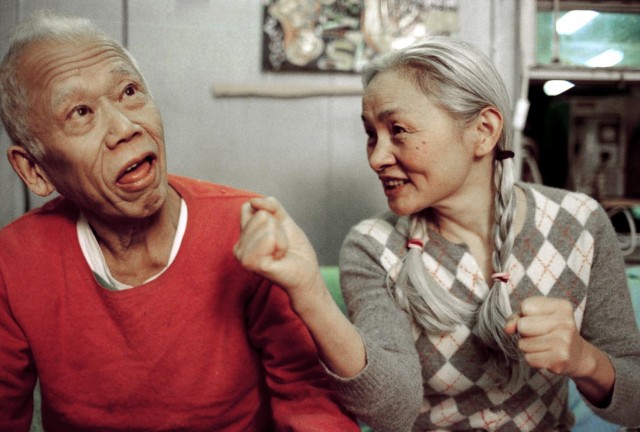
Documentary tells the engaging story of a pair of Japanese artists and the life they have made for themselves in Brooklyn
CUTIE AND THE BOXER (Zachary Heinzerling, 2013)
Film Society of Lincoln Center
Elinor Bunin Munroe Film Center, Howard Gilman Theater
Sunday, December 22, 2:00, and Tuesday, December 24, 7:00
Series runs December 20-26
212-875-5601
www.filmlinc.com
www.facebook.com/cutieandtheboxer
 Zachary Heinzerling’s Cutie and the Boxer is a beautifully told story of love and art and the many sacrifices one must make to try to succeed in both. In 1969, controversial Japanese Neo Dada action painter and sculptor Ushio Shinohara came to New York City, looking to expand his career. According to the catalog for the recent MoMA show “Tokyo 1955-1970: A New Avant-Garde,” which featured four works by Ushio, “American art had seemed to him to be ‘marching toward the glorious prairie of the rainbow and oasis of the future, carrying all the world’s expectations of modern painting.’” Four years later, he met nineteen-year-old Noriko, who had left Japan to become an artist in New York as well. The two fell in love and have been together ever since, immersed in a fascinating relationship that Heinzerling explores over a five-year period in his splendid feature-length theatrical debut. Ushio and Noriko live in a cramped apartment and studio in DUMBO, where he puts on boxing gloves, dips them in paint, and pounds away at large, rectangular canvases and builds oversized motorcycle sculptures out of found materials. Meanwhile, Noriko, who has spent most of the last forty years taking care of her often childlike husband and staying with him through some rowdy times and battles with the bottle, is finally creating her own work, an R. Crumb-like series of drawings detailing the life of her alter ego, Cutie, and her often cruel husband, Bullie. (“Ushi” means “bull” in Japanese.) While Ushio is more forthcoming verbally in the film, mugging for the camera and speaking his mind, the pig-tailed Noriko is far more tentative, so director and cinematographer Heinzerling brings her tale to life by animating her work, her characters jumping off the page to show Cutie’s constant frustration with Bullie.
Zachary Heinzerling’s Cutie and the Boxer is a beautifully told story of love and art and the many sacrifices one must make to try to succeed in both. In 1969, controversial Japanese Neo Dada action painter and sculptor Ushio Shinohara came to New York City, looking to expand his career. According to the catalog for the recent MoMA show “Tokyo 1955-1970: A New Avant-Garde,” which featured four works by Ushio, “American art had seemed to him to be ‘marching toward the glorious prairie of the rainbow and oasis of the future, carrying all the world’s expectations of modern painting.’” Four years later, he met nineteen-year-old Noriko, who had left Japan to become an artist in New York as well. The two fell in love and have been together ever since, immersed in a fascinating relationship that Heinzerling explores over a five-year period in his splendid feature-length theatrical debut. Ushio and Noriko live in a cramped apartment and studio in DUMBO, where he puts on boxing gloves, dips them in paint, and pounds away at large, rectangular canvases and builds oversized motorcycle sculptures out of found materials. Meanwhile, Noriko, who has spent most of the last forty years taking care of her often childlike husband and staying with him through some rowdy times and battles with the bottle, is finally creating her own work, an R. Crumb-like series of drawings detailing the life of her alter ego, Cutie, and her often cruel husband, Bullie. (“Ushi” means “bull” in Japanese.) While Ushio is more forthcoming verbally in the film, mugging for the camera and speaking his mind, the pig-tailed Noriko is far more tentative, so director and cinematographer Heinzerling brings her tale to life by animating her work, her characters jumping off the page to show Cutie’s constant frustration with Bullie.
During the course of the too-short eighty-two-minute film — it would have been great to spend even more time with these unique and compelling figures — the audience is introduced to the couple’s forty-year-old son, who has some issues of his own; Guggenheim senior curator of Asian Art Alexandra Munroe, who stops by the studio to consider purchasing one of Ushio’s boxing paintings for the museum; and Chelsea gallery owner Ethan Cohen, who represents Ushio. But things never quite take off for Ushio, who seems to always be right on the cusp of making it. Instead, the couple struggles to pay their rent. One of the funniest, yet somehow tragic, scenes in the film involves Ushio packing up some of his sculptures — forcing them into a suitcase like clothing — and heading back to Japan to try to sell some pieces. Cutie and the Boxer is a special documentary that gets to the heart of the creative process as it applies both to art and love, focusing on two disparate people who have made a strange yet thoroughly charming life for themselves. Cutie and the Boxer is screening December 22 at 2:00, followed by a Q&A with Heinzerling, and December 24 at 7:00 as part the Film Society of Lincoln Center series “For Your Consideration: Documentary Oscar Hopefuls,” which runs December 20-26 and consists of all fifteen nonfiction features that have made the Academy Awards short-list, including Blackfish, The Act of Killing, Life According to Sam, The Crash Reel, First Cousin Once Removed, and Which Way Is the Front Line from Here? The festival will be followed December 27 – January 2 by “For Your Consideration: Foreign Oscar Hopefuls,” comprising such international fare as Wong Kar-wai’s The Grandmaster, Thomas Vinterberg’s The Hunt, Kleber Mendonça Filho’s Neighboring Sounds, and Haifaa Al Mansour’s Wadjda.
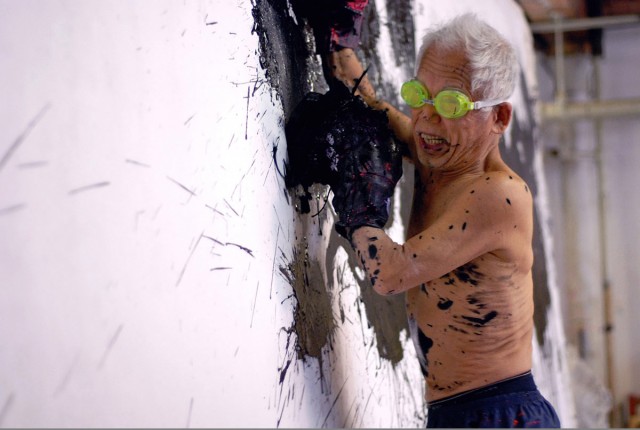
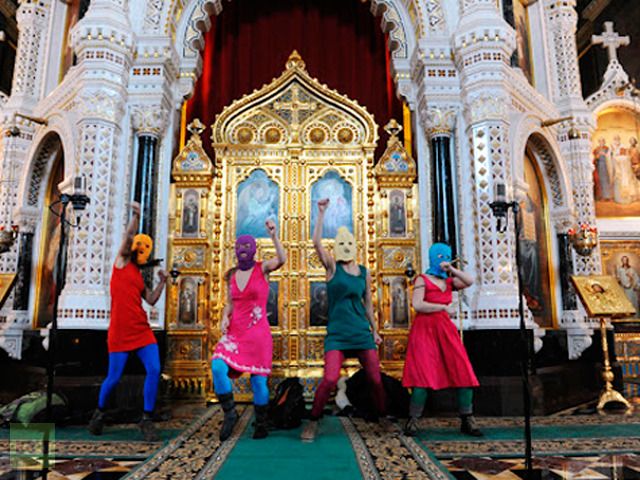
 The slogan “Free Pussy Riot!” is being shouted around the world — and was even seen on Madonna’s back — ever since the Russian government arrested three members of punk collective Pussy Riot after they staged an anarchic performance of less than one minute of “Mother Mary, Banish Putin!” at Christ the Savior Cathedral in Moscow on February 21, 2012. British documentary producer Mike Lerner and Russian filmmaker Maxim Pozdorovkin follow the sensationalistic trial of Pussy Riot leaders Maria “Masha” Alyokhina, Nadezhda “Nadia” Tolokonnikova, and Yekaterina “Katia” Samutsevich as they each face years in prison for social misconduct and antireligious behavior for what some consider a sacrilegious crime and others view as freedom of speech. The three women do a lot of eye rolling and smiling in court as they are enclosed in a glass booth, proud and unashamed of what they did, continuing to make their points about the separation between church and state, feminism, freedom, and the seemingly unlimited power of Vladimir Putin. Lerner and Pozdorovkin speak with Masha’s mother and Nadia’s and Katia’s fathers, all of whom fully support their daughters’ beliefs and discuss what their children were like growing up. Meanwhile, other members of Pussy Riot and men and women across the globe take to the streets and airwaves to try to help free the incarcerated trio, who are responsible for such songs as “Kill the Sexist,” “Death to Prison, Freedom to Protests,” and “Putin Lights Up the Fires.” Pussy Riot: A Punk Prayer is screening December 20-21 as part the Film Society of Lincoln Center series “For Your Consideration: Documentary Oscar Hopefuls,” which runs December 20-26 and consists of all fifteen nonfiction features that have made the Academy Awards short-list, including Cutie and the Boxer, Dirty Wars, Stories We Tell, Blackfish, and 20 Feet from Stardom. The festival will be followed December 27 – January 2 by “For Your Consideration: Foreign Oscar Hopefuls,” comprising such international fare as Wong Kar-wai’s The Grandmaster, Thomas Vinterberg’s The Hunt, Kleber Mendonça Filho’s Neighboring Sounds, and Haifaa Al Mansour’s Wadjda.
The slogan “Free Pussy Riot!” is being shouted around the world — and was even seen on Madonna’s back — ever since the Russian government arrested three members of punk collective Pussy Riot after they staged an anarchic performance of less than one minute of “Mother Mary, Banish Putin!” at Christ the Savior Cathedral in Moscow on February 21, 2012. British documentary producer Mike Lerner and Russian filmmaker Maxim Pozdorovkin follow the sensationalistic trial of Pussy Riot leaders Maria “Masha” Alyokhina, Nadezhda “Nadia” Tolokonnikova, and Yekaterina “Katia” Samutsevich as they each face years in prison for social misconduct and antireligious behavior for what some consider a sacrilegious crime and others view as freedom of speech. The three women do a lot of eye rolling and smiling in court as they are enclosed in a glass booth, proud and unashamed of what they did, continuing to make their points about the separation between church and state, feminism, freedom, and the seemingly unlimited power of Vladimir Putin. Lerner and Pozdorovkin speak with Masha’s mother and Nadia’s and Katia’s fathers, all of whom fully support their daughters’ beliefs and discuss what their children were like growing up. Meanwhile, other members of Pussy Riot and men and women across the globe take to the streets and airwaves to try to help free the incarcerated trio, who are responsible for such songs as “Kill the Sexist,” “Death to Prison, Freedom to Protests,” and “Putin Lights Up the Fires.” Pussy Riot: A Punk Prayer is screening December 20-21 as part the Film Society of Lincoln Center series “For Your Consideration: Documentary Oscar Hopefuls,” which runs December 20-26 and consists of all fifteen nonfiction features that have made the Academy Awards short-list, including Cutie and the Boxer, Dirty Wars, Stories We Tell, Blackfish, and 20 Feet from Stardom. The festival will be followed December 27 – January 2 by “For Your Consideration: Foreign Oscar Hopefuls,” comprising such international fare as Wong Kar-wai’s The Grandmaster, Thomas Vinterberg’s The Hunt, Kleber Mendonça Filho’s Neighboring Sounds, and Haifaa Al Mansour’s Wadjda.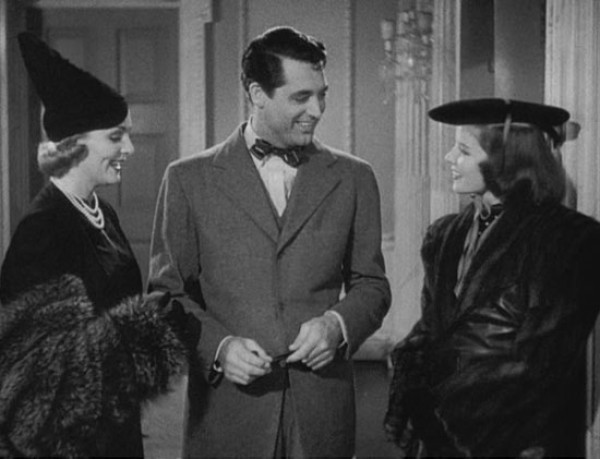
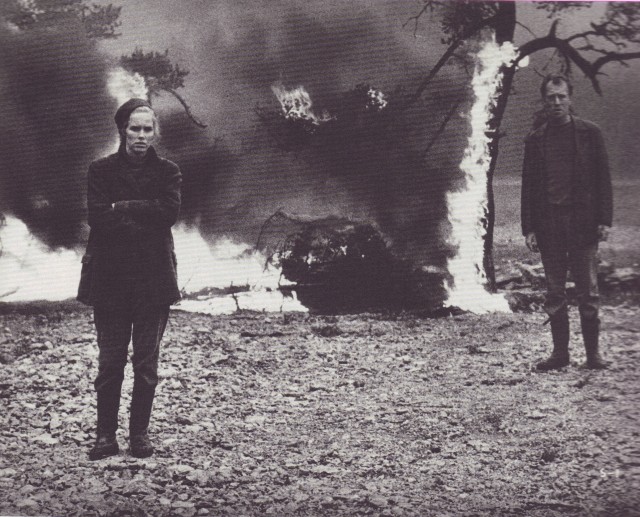
 Ingmar Bergman’s Shame is a brilliant examination of the physical and psychological impact of war, as seen through the eyes of a happily married couple who innocently get caught in the middle of the brutality. Jan (Max von Sydow) and Eva Rosenberg (Liv Ullmann) have isolated themselves from society, living without a television and with a broken radio, maintaining a modest farm on a relatively desolate island a ferry ride from the mainland. As the film opens, they are shown to be a somewhat ordinary husband and wife, brushing their teeth, making coffee, and discussing having a child. But soon they are thrust into a horrific battle between two unnamed sides, fighting for reasons that are never given. As Jan and Eva struggle to survive, they are forced to make decisions that threaten to destroy everything they have built together. Shot in stark black-and-white by master cinematographer Sven Nykvist, Shame is a powerful, emotional antiwar statement that makes its point through intense visual scenes rather than narrative rhetoric. Jan and Eva huddle in corners or nearly get lost in crowds, then are seen traversing a smoky, postapocalyptic landscape riddled with dead bodies. Made during the Vietnam War, Shame is Bergman’s most violent, action-filled film; bullets can be heard over the opening credits, announcing from the very beginning that this is going to be something different from a director best known for searing personal dramas. However, at its core, Shame is just that, a gripping, intense tale of a man and a woman who try to preserve their love in impossible times. Ullmann and von Sydow both give superb, complex performances, creating believable characters who will break your heart. Shame is screening December 14 and 18 at the Elinor Bunin Munroe Film Center as part of the Film Society of Lincoln Center series “Liv & Ingmar: The Films,” being held in conjunction with the theatrical release of Dheeraj Akolkar’s poetic new documentary, Liv & Ingmar; the festival continues with such other Ullmann/Bergman pairings as Scenes from a Marriage, Saraband, The Passion of Anna, and Persona.
Ingmar Bergman’s Shame is a brilliant examination of the physical and psychological impact of war, as seen through the eyes of a happily married couple who innocently get caught in the middle of the brutality. Jan (Max von Sydow) and Eva Rosenberg (Liv Ullmann) have isolated themselves from society, living without a television and with a broken radio, maintaining a modest farm on a relatively desolate island a ferry ride from the mainland. As the film opens, they are shown to be a somewhat ordinary husband and wife, brushing their teeth, making coffee, and discussing having a child. But soon they are thrust into a horrific battle between two unnamed sides, fighting for reasons that are never given. As Jan and Eva struggle to survive, they are forced to make decisions that threaten to destroy everything they have built together. Shot in stark black-and-white by master cinematographer Sven Nykvist, Shame is a powerful, emotional antiwar statement that makes its point through intense visual scenes rather than narrative rhetoric. Jan and Eva huddle in corners or nearly get lost in crowds, then are seen traversing a smoky, postapocalyptic landscape riddled with dead bodies. Made during the Vietnam War, Shame is Bergman’s most violent, action-filled film; bullets can be heard over the opening credits, announcing from the very beginning that this is going to be something different from a director best known for searing personal dramas. However, at its core, Shame is just that, a gripping, intense tale of a man and a woman who try to preserve their love in impossible times. Ullmann and von Sydow both give superb, complex performances, creating believable characters who will break your heart. Shame is screening December 14 and 18 at the Elinor Bunin Munroe Film Center as part of the Film Society of Lincoln Center series “Liv & Ingmar: The Films,” being held in conjunction with the theatrical release of Dheeraj Akolkar’s poetic new documentary, Liv & Ingmar; the festival continues with such other Ullmann/Bergman pairings as Scenes from a Marriage, Saraband, The Passion of Anna, and Persona.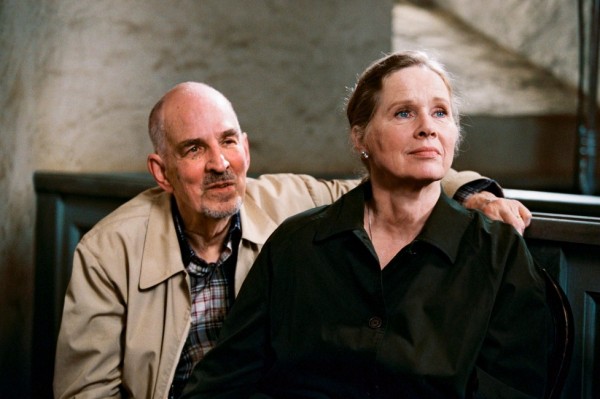
 Two-time Oscar-nominated Norwegian actress Liv Ullmann intimately and poetically discusses her five-decade-long personal and professional relationship with Swedish director Ingmar Bergman in Dheerai Alkolkar’s beautifully rendered Liv & Ingmar. Ullmann returns to Bergman’s house on Faro Island as she openly and honestly shares details of their long involvement, which began in 1965 when they were filming Persona; Ullmann was twenty-five, Bergman forty-six. Each was married and ended up leaving their spouse for what became a tumultuous five-year affair, after which they remained friends and colleagues, ultimately making twelve films together between 1966 and 2004. Alkolkar and cinematographer Hallvard Bræin zoom in on Ullmann’s expressive face as her memories go from love, loneliness, rage, and pain to longing and friendship. Alkolkar intersperses related film clips, behind-the-scenes footage, home movies, and snapshots as Ullmann walks along the beach and reads from her 1977 memoir, Changing; the film also features Samuel Fröler in voice-over reading from Bergman’s letters and autobiography, The Magic Lantern. Among the works featured prominently are Shame and Scenes from a Marriage, which eerily evoke Ullmann and Bergman’s real-life relationship. Liv & Ullmann serves as a lovely coda to this lasting partnership, which continues in its own unique way even after Bergman’s death in 2007 at the age of eighty-nine. In conjunction with the theatrical release of the film at Lincoln Center, the Film Society will also be screening nine works starring Ullmann and directed by Bergman: Shame, The Passion of Anna, Cries and Whispers, Face to Face, Scenes from a Marriage, Saraband, Hour of the Wolf, Persona, and Autumn Sonata.
Two-time Oscar-nominated Norwegian actress Liv Ullmann intimately and poetically discusses her five-decade-long personal and professional relationship with Swedish director Ingmar Bergman in Dheerai Alkolkar’s beautifully rendered Liv & Ingmar. Ullmann returns to Bergman’s house on Faro Island as she openly and honestly shares details of their long involvement, which began in 1965 when they were filming Persona; Ullmann was twenty-five, Bergman forty-six. Each was married and ended up leaving their spouse for what became a tumultuous five-year affair, after which they remained friends and colleagues, ultimately making twelve films together between 1966 and 2004. Alkolkar and cinematographer Hallvard Bræin zoom in on Ullmann’s expressive face as her memories go from love, loneliness, rage, and pain to longing and friendship. Alkolkar intersperses related film clips, behind-the-scenes footage, home movies, and snapshots as Ullmann walks along the beach and reads from her 1977 memoir, Changing; the film also features Samuel Fröler in voice-over reading from Bergman’s letters and autobiography, The Magic Lantern. Among the works featured prominently are Shame and Scenes from a Marriage, which eerily evoke Ullmann and Bergman’s real-life relationship. Liv & Ullmann serves as a lovely coda to this lasting partnership, which continues in its own unique way even after Bergman’s death in 2007 at the age of eighty-nine. In conjunction with the theatrical release of the film at Lincoln Center, the Film Society will also be screening nine works starring Ullmann and directed by Bergman: Shame, The Passion of Anna, Cries and Whispers, Face to Face, Scenes from a Marriage, Saraband, Hour of the Wolf, Persona, and Autumn Sonata.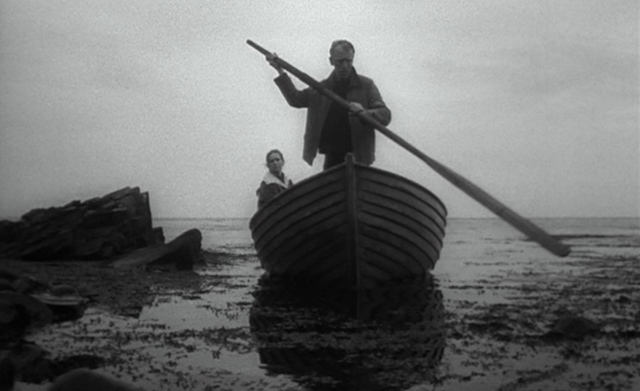
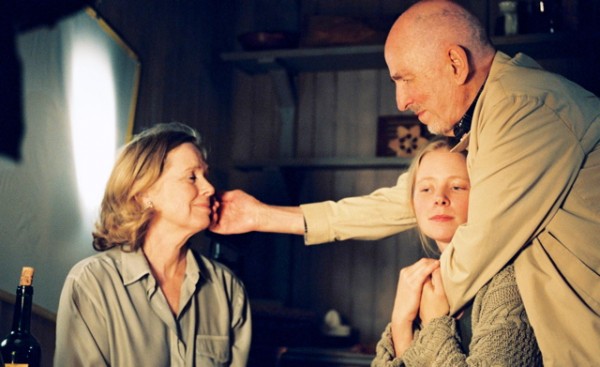
 In Saraband, masterful writer-director Ingmar Bergman returns to the story of Marianne (Liv Ullmann) and Johan (Erland Josephson), first brought to life in the heartbreaking Scenes from a Marriage in 1973. Marianne, who hasn’t seen her ex-husband in thirty years, suddenly decides to pay the aging recluse a visit, resurrecting emotions both good and bad. Shot digitally, what purports to be Bergman’s swan song looks more like a TV movie than a theatrical release; in fact, it was made for Swedish television, as was the earlier work, but this one contains far less energy. While there are moments of brilliance, there are also scenes of mediocrity and mundanity that fall flat. The framing device of having Marianne speaking directly to the camera as she looks at old photos detracts from the overall impact as well. But it is great to see Josephson and Ullmann together again. The most fascinating new character, and one that fits well in the Bergman oeuvre, could very well be Henrik (Borje Ahlstedt), a complex, scary man with serious problems between him and his father as well as with his daughter, Karin (Julia Dufvenius). Saraband is screening December 14 and 18 at the Elinor Bunin Munroe Film Center as part of the Film Society of Lincoln Center series “Liv & Ingmar: The Films,” being held in conjunction with the theatrical release of Dheeraj Akolkar’s poetic new documentary, Liv & Ingmar; the festival continues with such other Ullmann/Bergman pairings as The Passion of Anna, Face to Face, Cries and Whispers, and Scenes from a Marriage.
In Saraband, masterful writer-director Ingmar Bergman returns to the story of Marianne (Liv Ullmann) and Johan (Erland Josephson), first brought to life in the heartbreaking Scenes from a Marriage in 1973. Marianne, who hasn’t seen her ex-husband in thirty years, suddenly decides to pay the aging recluse a visit, resurrecting emotions both good and bad. Shot digitally, what purports to be Bergman’s swan song looks more like a TV movie than a theatrical release; in fact, it was made for Swedish television, as was the earlier work, but this one contains far less energy. While there are moments of brilliance, there are also scenes of mediocrity and mundanity that fall flat. The framing device of having Marianne speaking directly to the camera as she looks at old photos detracts from the overall impact as well. But it is great to see Josephson and Ullmann together again. The most fascinating new character, and one that fits well in the Bergman oeuvre, could very well be Henrik (Borje Ahlstedt), a complex, scary man with serious problems between him and his father as well as with his daughter, Karin (Julia Dufvenius). Saraband is screening December 14 and 18 at the Elinor Bunin Munroe Film Center as part of the Film Society of Lincoln Center series “Liv & Ingmar: The Films,” being held in conjunction with the theatrical release of Dheeraj Akolkar’s poetic new documentary, Liv & Ingmar; the festival continues with such other Ullmann/Bergman pairings as The Passion of Anna, Face to Face, Cries and Whispers, and Scenes from a Marriage.